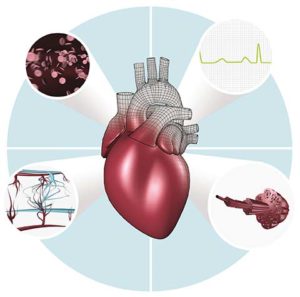
The European Society of Cardiology (ESC) unveiled guidelines for treatment of supraventricular tachycardia (SVT) on the opening day of its Congress (ESC 2019; 31 August–4 September, Paris, France). Simultaneously published online in the European Heart Journal, the document provides recommendations for all types of SVT, and cements the role of catheter ablation therapy, with a press release from the ESC describing it as “revolutionising care”.
The consensus document is based on an up-to-date review of the evidence and summarises the latest developments and advances since the last ESC guidelines on SVTs in 2003, as well as areas for further research. Although drug therapies for SVTs have not fundamentally changed in the past 16 years, the availability of catheter ablation has led to major changes in clinical practice. The guidelines provide general recommendations for the management of adults with SVT based on the principles of evidence-based medicine, but the authors point out that, because evidence and expert opinions from several countries are included, some antiarrhythmic approaches may not have the approval of governmental regulatory agencies in all countries. In addition, many of the drugs that were recommended previously have not been considered in the 2019 guidelines.
Professor Demosthenes Katritsis (Hygeia Hospital, Athens, Greece) is a chairperson of the guidelines taskforce. In the press release, he points out: “Catheter ablation techniques and technology have evolved in a way that we can now offer this treatment modality to most of our patients with SVT.”
SVTs have a prevalence of approximately 0.2% in the general population, with women at twice the risk of men, and those aged≥ 65 years at more than five times the risk of younger people. If left untreated, SVTs increase the risk of stroke and affect quality of life. Antiarrhythmic drugs are useful for acute episodes, but have limited value for long-term use, due to relatively low efficacy and related side-effects.
Among the concepts that have been revised in the updated guidance are:
- Drug therapy for inappropriate sinus tachycardia and focal atrial tachycardia
- Therapeutic options for acute conversion and anticoagulation of atrial flutter
- Therapy of atrioventricular nodal re-entrant tachycardia
- Therapy of antidromic atrioventricular re-entrant tachycardia and pre-excited atrial fibrillation
- Management of patients with asymptomatic pre-excitation
- Diagnosis and therapy of tachycardiomyopathy.
SVT is linked with a higher risk of complications during pregnancy, and specific recommendations are provided for pregnant women. All antiarrhythmic drugs should be avoided, if possible, within the first trimester of pregnancy. However, if necessary, some drugs may be used with caution during that period. The guidelines also suggest that if ablation is necessary during pregnancy, non-fluoroscopic mapping be used.
“Pregnant women with persistent arrhythmias that do not respond to drugs, or for whom drug therapy is contraindicated or not desirable, can now be treated with catheter ablation using new techniques that avoid exposing themselves or their baby to harmful levels of radiation,” says Katritsis.
The recommendations provide some key messages. These include:
- Vagal manoeuvres and adenosine are the treatments of choice for the acute therapy of SVT, and may also provide important diagnostic information.
- Verapamil is not recommended in wide QRS-complex tachycardia of unknown aetiology.
- In all re-entrant and most focal arrhythmias, catheter ablation should be offered as an initial choice to patients, after having explained in detail the potential risks and benefits.
- Patients with macro re-entrant tachycardias following atrial surgery should be referred to specialised centres for ablation.
- In post-atrial fibrillation (AF) ablation atrial tachycardias (ATs), focal or macro re-entrant, ablation should be deferred for ≥three months after AF ablation, when possible.
- Ablate atrioventricular nodal re-entrant tachycardia (AVNRT), typical or atypical, with lesions in the anatomical area of the nodal extensions, either from the right or left septum.
- AVNRT, typical or atypical, can now be ablated with almost no risk of atrioventricular (AV) block.
- Do not use sotalol in patients with SVT.
- Do not use flecainide or propafenone in patients with left bundle branch block (LBBB), or ischaemic or structural heart disease.
- If a patient undergoes an electrophysiological assessment and is found to have an accessory pathway with high-risk characteristics, catheter ablation should be performed.
The guidance also urges physicians to consider tachycardiomyopathy (TCM) in patients with reduced left ventricular function and SVT, and to use ablation as the treatment of choice for TCM due to SVT. Atrioventricular (AV) nodal ablation with subsequent biventricular or His-bundle pacing (“ablate and pace”) should be considered if the SVT cannot be ablated.
Gaps in the evidence are highlighted, and include that the exact circuit of AVNRT, which is the most common regular arrhythmia, remains unresolved, the proper management of asymptomatic pre-excitation and strict catheter ablation indications have not been established, and that the genetics of SVT have not been adequately studied. There is evidence for familial forms of AVNRT, atrioventricular re-entrant tachycardia (AVRT), sinus tachycardia, and AT, but data are scarce.
The document concludes: “The past decade has witnessed a rapid evolution of ablation equipment and electrode-guiding systems, which has resulted in more controllable and safer procedures. Intracardiac echocardiography, robotic techniques, and sophisticated anatomical navigation systems have been developed, and it is now possible to perform ablation without exposing the operator to radiation and ergonomically unfavourable positions. New materials for electrodes and other equipment have allowed the concept of a radiation-free electrophysiology laboratory with the use of CMR [cardiac magnetic resonance imaging]. The vision of a fully radiation-free, magnetic laboratory in the future is not science fiction anymore.”












